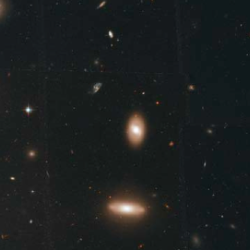Source Institutions
Source Institutions
Add to list Go to activity
Activity link broken? See if it's at the internet archive

In this activity, learners will first learn the basics of galaxy classification and grouping. Then, learners use Hubble Space Telescope (HST) images to discover the "morphology-density effect" and make hypotheses about its causes. This lesson guide includes handouts for learners, explanations, and extensions.
- Under 5 minutes
- 30 to 45 minutes
- free per group of students
- Ages 14 - 18
- Activity, Lesson/Lesson Plan
- English
Quick Guide
Materials List (per group of students)
- Copy of student guide
- Calculator
- Magnifying glass (a linen tester works well)
- Pen/pencil
Subjects
-
Earth and Space Science
-
Astronomy
- Stars and Galaxies
- Probes, Satellites and Spacecraft
- Solar System
-
Astronomy
-
Mathematics
-
Algebra
- Patterns
-
Data Analysis and Probability
- Data Analysis
- Data Collection
- Data Representation
- Probability
-
Measurement
- Rate
- Reasoning and Proof
- Representation
-
Algebra
-
The Nature of Technology
-
The Design Process
- Problem Solving
-
The Design Process
-
The Nature of Science
-
The Scientific Process
- Conducting Investigations
- Gathering Data
- Formulating Explanations
- Communicating Results
-
The Scientific Process
Audience
To use this activity, learners need to:
- see
- read
- touch
Learning styles supported:
- Involves hands-on or lab activities
Other
Components that are part of this resource:
- Student Guide (with negatives of images)
- Teacher Guide (with negatives of images)
- Student Guide (with positives)
- Teacher Guide (with positives)
Includes alignment to state and/or national standards:
This resource is part of:
Access Rights:
- Free access
By:
- Education and Outreach Office, McDonald Observatory
Rights:
- All rights reserved, The University of Texas McDonald Observatory, 2011
Funding Source:
- NASA (Space Telescope Science Institute, operated by the Association of Universities for Research in Astronomy), HST-EO-10861.35-A
